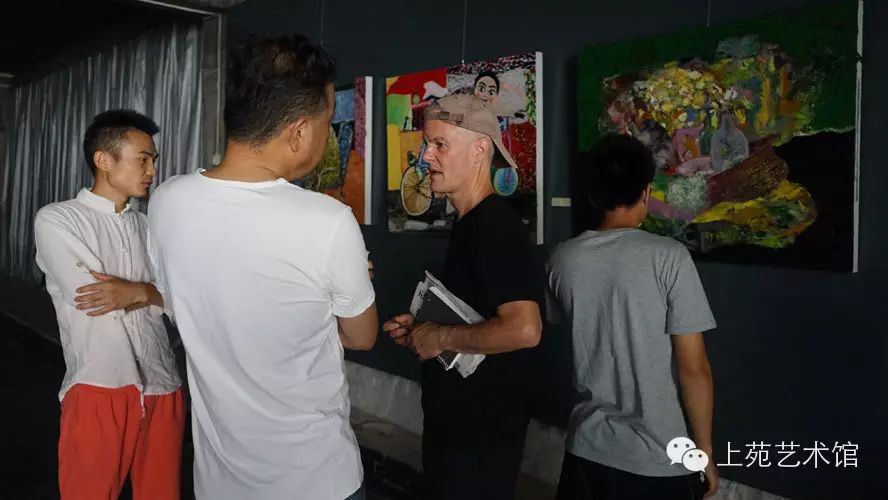|
【上苑藝評之馬賽克】劉赟-忽略表象
[2015-9-23 8:14:14]
【上苑藝評之馬賽克】劉赟-忽略表象
Christopher Pelley :Liu Yun Ignore Appearance
看著劉赟的畫會不由得想到畢加索,馬蒂斯和巴洛克的藝術在他的作品中的影響。這些巨人20世紀的藝術留下深刻的影響,但現在代表西方的前衛藝術不僅進軍到歷史書也滲透至拍賣行了。但這些反叛對于東方代表什么呢?馬蒂斯,畢加索和布拉克代表中國藝術的景象,是實質的社會心理的景象,這會溶入未來烏托邦般的未來的夢嗎?出現在中國的情況是,普遍的有控制力有影響力的形象已經坍塌,這些殘留的元素正在被重組。這個過程與科斯塔馬蒂兄弟Cosmati作為不無相似之處,他們在13世紀羅馬收集毀壞了的羅馬帝國時代的建筑的彩色大理石的碎片并重新以新的設計配置這些碎片鋪教會的地板。這是很自然地的會使用這些材料并具有觀念。
Looking at the paintings of Liu Yun onecannot help but notice elements of Matisse, Picasso and Braque in hiswork. These towering giants of 20thcentury art have cast a long shadow of influence, but now represent for theWest a quaint avant garde that has marched on into the safety of the historybooks and auction houses. But what dothese former rebels represent to the East? Do Matisse, Picasso and Braque represent tradition and solidity as thephysical, social and psychological landscape of China dissolves into a dreamyfuture of yet another utopia? Thereappears in China to be a general collapse of meaning that potent images onceheld, and from the wreckage, elements are re-purposed. This process is not unlike the Cosmati brotherswho in 13th century Rome collected fragments of colored marble fromruined imperial era buildings and reconfigured these fragments to pave theflooring of churches with exuberant new designs. It is the inevitable use and re-use ofmaterials, a spolia of ideas and imagery.

本文作者馬賽克在與畫家劉赟交流
劉赟目前的展覽告誡觀眾“應該忽略表面的形象”。如果一個人去拿早期繪畫傳統作參考,他會發現強烈的心理反應,就好像眼前上演一出強烈戲劇。大多數作品都是以男性的目光畫女性。在《女人花》這幅作品中, 女人跪著, 她的腳盤在臀部之下, 她的背部拱形是經典的“被釘住”的姿勢。她的臉是畢卡索式的,畢加索認為要同時多視點多視角觀看, 劉云則詮釋為單個角度的視點,畫中女性的臉既感覺朝這邊又感覺朝那邊, 但只會讓觀眾通過一個空虛的眼睛來感受。《跳舞》這幅畫向我們展示了一個跳脫衣舞的酒吧。在女人胸罩和內褲轉動前流口水的色迷迷的男人伸出手拖住女人的胸罩帶子。她有2個臉。但是哪一個是更真實?云提出了這個問題,我們的眼睛投在悲傷的面具還是更現實的頭往后仰、嘴唇微張、假裝快樂的那一個?。《渴望愛》令人不安的坐著,她的身體輪廓得到的形狀完全是一把軟墊椅子。有多重面孔吸引注意力, 焦慮、隔離、異化和物化的女性被劉云處理成既模糊又明亮快樂。
In introducing the work in his currentexhibition, Liu Yun admonished the viewers to “ignore the superficialimage”. If one moves past the referencesto an earlier painting tradition, one discovers intense psychological dramas beingplayed out in front of one’s eyes. The women, most of the paintings are aboutwomen, appear to be painted for the male gaze. In “Woman Like a Flower”, a woman kneels, her feet tucked beneath herbuttocks, her back arched in a classic “pin up” pose. Her face is picassoid, but where Picassosuggested the simultaneity of multiple viewpoints from the viewer’sperspective, Liu suggests a mask from the point of view of the viewed. Her faceshifts here and there, and only makes contact with the viewer via a blankgeneric eye. “Dancing” shows us a barroom strip tease. The woman in her braand panties gyrates in front of drooling ogling men as a hand reaches out togive a tug on her bra strap. She has 2faces. But which one is more real Yunasks – the mask with eye cast down in sadness, or the more realistic one withhead thrown back and lips slightly parted feigning pleasure?. “Yearning for Love” sits uncomfortably, herbody contours echoed by the shape of the fully upholstered chair. Again the multiple face casts its attentionelsewhere, the anxiety unmistakable. Theisolation, alienation and objectification of these women is obscure by Liu’suse of patterning and bright happy colors.

畫家劉赟
作品中有著馬蒂斯的花紋圖像伴隨著劉赟自己的文化偏愛。用紡織圖案描繪了典型的中國人。一組作品中的物象來自流行的中國紡織品,有李花、鳥類等景觀元素, 所有這些都被處理成了明亮和快樂的調子。在《鳥的天堂》中可以看到卡通般的鳥并幾乎可以聽到鳥叫。相比上述繪畫,另一組作品乍看起來又有了一個略有不同的含義,“童年的夢想” 這一系列體現了童年夢想的實現——童年時他想要一輛自行車, 愿喂養一只鳥。劉赟用繪畫實現了想象,他的生活多么令人高興和與眾不同,這些繪畫中的實現是賦予的禮物。
The nod to Matisse’s love of patternedimagery comes with Liu’s own cultural bias. Some of the fabrics that are portrayed are distinctly Chinese. Images from popular Chinese textiles spillover to a group of paintings that incorporate plum blossoms, elements oflandscape and birds, all again bright and happy. One can almost hear the chirping of thecartoon like birds in “Birds of Paradise”. In context with a nearby painting, these works take on a slightlydifferent meaning than first appears. “Childhood Dreams” embodies unfulfilled childhood dreams – the wish fora bicycle, the wish for a bird. Yunimagines how happy and different his life would have been, had he been grantedthese gifts.
歷來母親們都告訴他們的孩子不要從封面判斷一本書, 劉赟的繪畫呼應了古老的諺語。有很多初看起來五彩繽紛,看似有趣的作品有一個難以掩蓋的真相。
For generations mothers have told theirchildren not to “judge a book by its cover”, and with these tightly constructedpaintings, Liu Yun echoes that proverb. There is a lot more than first meets the eye in his colorful andseemingly playful works. One can mask, but the truth cannot be hidden.
馬賽克(Christopher Pelley)
2015年于北京 Beijing2015
作者簡介:
馬賽克(Christopher Pelley)美國紐約人,亞利桑那州州立大學Bachelor of Fine Arts 美術學士,上苑藝術館2014-2015駐館藝術家。現為上苑藝術館駐館畫家、跨界藝術批評專員。











------------------------

-------------
上苑 & 鳥巢-文學藝術國際聯盟(簡稱:國際文盟)
International Network of Literature and Art(INLA)
電話: 010-60635299 60635757
Website: http://www.inlac.cc/
http://www.sh-yinshua.com/
交通指南□北京東直門916路、942路到懷柔,轉杯柔-沙峪口(上苑藝術館)
□京承高速12出口 > 右拐過水渠西行2KM > 良善莊路口北行到底>右拐300m路北


查看6924次
|
